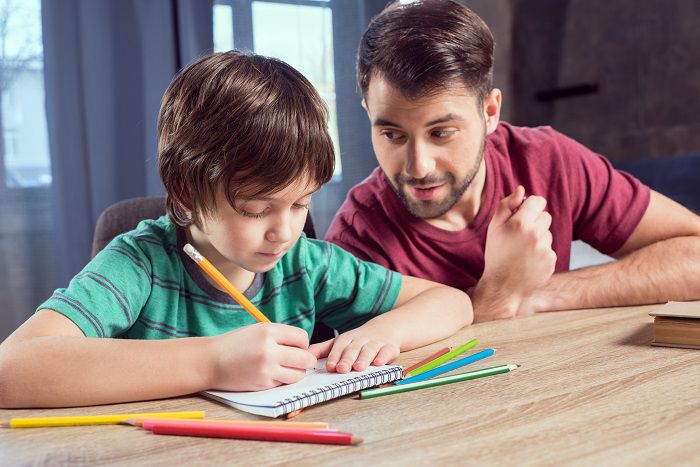
A child with a learning difficulty will probably respond better to instruction and guidance from someone that they know very well and feel comfortable with, and a parent is the ideal choice.
It also gives the child the opportunity to be the entire focus of the lesson. In a traditional classroom a teacher will have to split their attention among students which could lead to the child’s mind wandering.
You can individualize the experience entirely and cater it to your child’s specific needs and work around any disadvantages they may have.
So if your child has ADHD and you think that homeschooling is the best option, here are a couple of tips that will help you along the way:
1. Take Regular Breaks
Children in school don’t really get to take many breaks. And when they do, it’s the teacher’s call when it happens and how long it lasts.
This is probably fine for most kids, but for the ones for whom focus is almost impossible, frequent breaks are essential.
In truth, everyone should take some breaks while working and studying because your productivity tends to waver after about 40-45 minutes, and for kids with ADHD it happens faster.
Maintaining productivity is already a struggle for them and if they don’t take a few minutes to let their brain recharge then focus will be nonexistent.
With some time and practice, you could probably build up to working for about 40 minutes at a time, but at the beginning be more flexible.
Try working for about 15 minutes and then take a 10 minute break. Let your child get up and wander around.
Working nonstop will never get you anywhere. You have to be patient and try to work at your child’s pace.
2. Remove Distractions
A child with ADHD will get distracted anyway, and you won’t be able to teach them unless you can minimize that.
So have a set workspace, and keep it free of anything that could be a potential distraction for the child.
Have a specific room that is exclusively for learning and studying.
That’s not to say that it should be a completely bland room either because that could make your child restless.
You can have artwork and the room can be well-designed workspace.
It might be a nice idea to have your workspace in a room that has multiple windows looking out into the garden.
The presence of the outdoors could help keep your child calm and not feel like they’re being shut in and isolated because of their condition.
Flowers can have that effect. What you could do is spruce up your garden so that the view from the room is a pleasant one.
Planting some perennials would do the trick. Here’s a guide to that from Gardener’s Path. Just one of the many ways you could ease the pressure for you child.
3. Maintain a Routine
When you get up in the morning, you put clothes on. This is pretty universal, and we don’t do it because we like putting clothes on. We do it because it’s routine.
This has been ingrained in our behaviour since we were young and we don’t question it, we just do it out of habit.
Through repetition, you can turn anything into a routine. Even a child with ADHD will dress themselves without getting distracted.
Prepare a daily routine so that it will begin to feel natural overtime. Depending on the child's age and focus work no more than 5 hours total with regular short breaks.
Having a longer break for lunch is a good idea. Having a daily routine will help with prioritization, instilling good habits and avoiding procrastination.
These are all important elements to fighting the effects of ADHD.
4. Declutter the Workspace

When a child’s desk is covered with a pile of different books and pieces of equipment, it can get pretty overwhelming.
It can make them feel like they’re surrounded by all of this work that needs to be completed and it can overload the mind of someone suffering from ADHD.
Stress will eradicate productivity, and a child with ADHD is unfortunately more susceptible to stress while they are trying to force themselves focus.
One thing at a time. Make sure the desk is clear of everything except for the specific subject you are working on.
Few books, few pens and pencils and when it’s time for the next lesson, put all of the previous lesson material away.
5. Keep it Interesting
It’s hard enough as it is to get children interested in their schoolwork, and an environment where a teacher is trying to do that with a large groups is not ideal for ADHD sufferers.
Even kids who share the same condition are still individuals at the end of the day, and they all learn and think differently.
You know your child better than anyone, you know their interests and you can tailor every lesson to them.
Ideas for making it interesting: Have fun with learning games, utilize audio books or recordings if your child learns better by ear, do some lessons on a computer.
It’s effective for ADHD students to keep things active and focus on doing.
Another good tip would be to start the day with a subject that they’re interested in to ease them into work and finish with another subject they like so that they have that to look forward to.
You’ll know how best to hold your child’s interest so be creative about this and try to sympathize with their reactions to specific subjects.
Conclusion
It’s all about helping your child to maintain their focus. It doesn't have to be frustating if you remember to gear the learning to your child's individual needs.
Your child’s success and ability does not have to be defined by ADHD.





